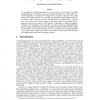Free Online Productivity Tools
i2Speak
i2Symbol
i2OCR
iTex2Img
iWeb2Print
iWeb2Shot
i2Type
iPdf2Split
iPdf2Merge
i2Bopomofo
i2Arabic
i2Style
i2Image
i2PDF
iLatex2Rtf
Sci2ools
SAGT
2010
Springer
2010
Springer
Complexity of Safe Strategic Voting
We investigate the computational aspects of safe manipulation, a new model of coalitional manipulation that was recently put forward by Slinko and White [11]. In this model, a potential manipulator v announces how he intends to vote, and some of the other voters whose preferences coincide with those of v may follow suit. Depending on the number of followers, the outcome could be better or worse for v than the outcome of truthful voting. A manipulative vote is called safe if for some number of followers it improves the outcome from v’s perspective, and can never lead to a worse outcome. In this paper, we study the complexity of finding a safe manipulative vote for a number of common voting rules, including Plurality, Borda, k-approval, and Bucklin, providing algorithms and hardness results for both weighted and unweighted voters. We also propose two ways to extend the notion of safe manipulation to the setting where the followers’ preferences may differ from those of the leader, a...
| Added | 30 Jan 2011 |
| Updated | 30 Jan 2011 |
| Type | Journal |
| Year | 2010 |
| Where | SAGT |
| Authors | Noam Hazon, Edith Elkind |
Comments (0)

